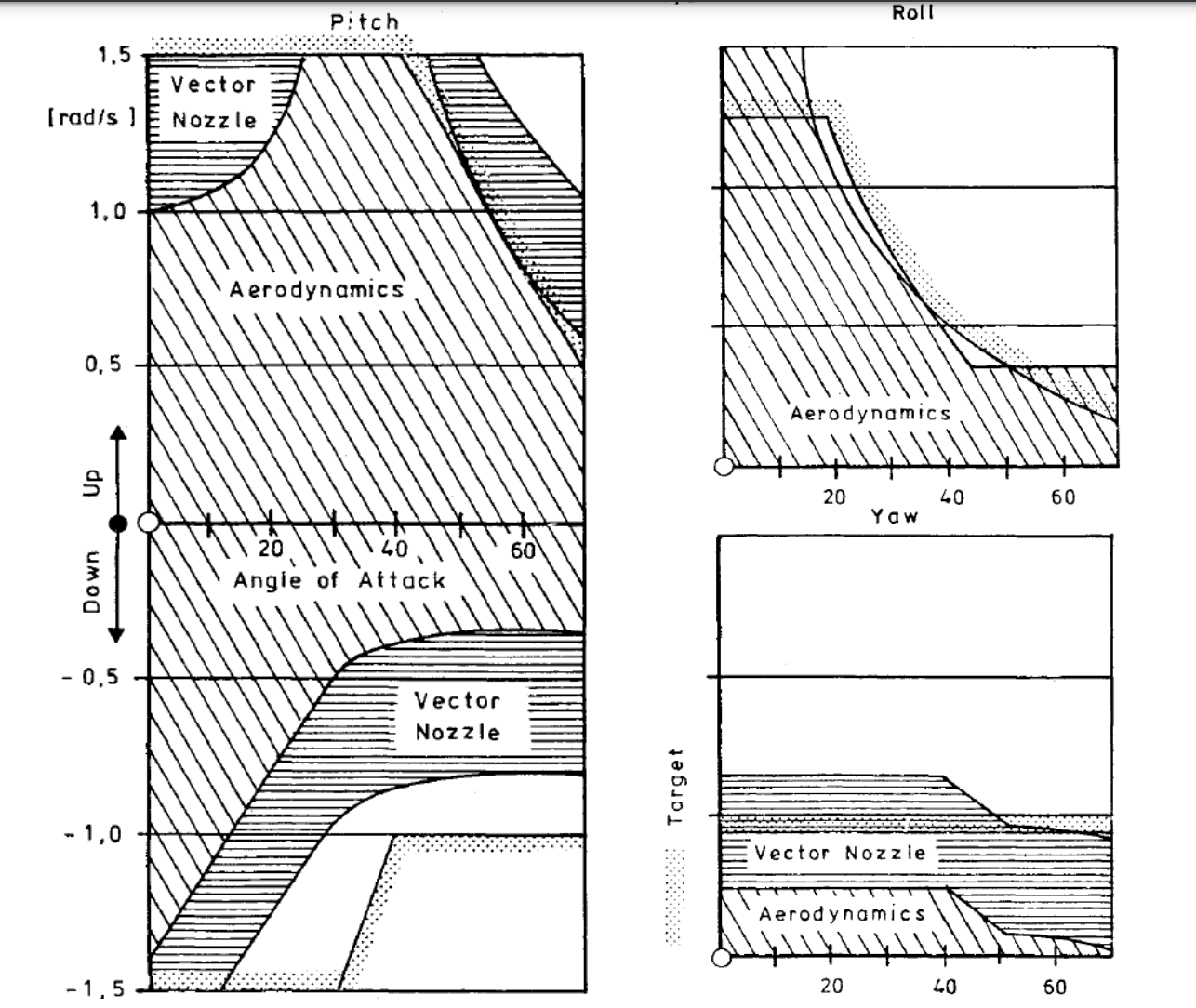PA,
there are various methods of TV, and TVC applied.
1. Harrier: 2-D split cold/hot exhaust, vectoring angles are downward relative to the aircraft longitudinal axis, giving a variable from thrust, or positive force normal to the longitudinal axis, or a combination of that or similar with a deceleration component. Viffing adds a vertical force that decouples the turning rate from the angle of the bank partially, still requires a vector in the desired turn, but the total normal force is a combination of lift and any thrust vectoring. Comes with some costs in EM state.
2. Sukhoi, limited axisymmetrical TVC. Gives increased agility, adds control authority to extend instantaneous rates to point nose. Has a force component for pitch rates, but that is also partially opposite the normal force from lift... for a pitch up by vectoring exhaust nozzles upwards, total lift force from the wing and body has to be increased to counter the negative component of the TVC vector. Not a problem if you have big wing areas and can generate reasonable CL/AOA. Instantaneous rate of turn is the benefit. Normal vectoring angles are around +-20 degrees from the longitudinal axis. Provides roll as well as yaw potential.
Note: any pitch TVC will increase wing bending load for a given g limit, the thrust counters the aerodynamic force required to achieve the total normal force to get the g... so TVC does come with a structural penalty, but great offsets.
3. F-22. 2-D, low RCS TVC. drops the yaw ability. Could do roll augment.
4. F-35: 2-D has a dedicated cold fan lift for TO/LDG, but does have the potential for TVC but is not indicated to be implemented. If it was it could be 2D or axisymmetric, with pitch and yaw, no roll. The design of intake suggests that it is not intended to do the Harrier Viffing deal.
5. J10B TVC: axisymmetrical TVC demo'd in 2018.
6. USSR, Yaks etc... dedicated lift engines, and always had a potential for pitch augmentation.
The F-22 has a Type III TVC nozzle which is in keeping with low RCS, all of the others, have type I nozzles.
Re g limits, only the harrier type TVC can unload the wing while achieving a given g loading. The g load limit may have a constraint on the flight control systems or fuselage itself but it is usually the wing bending load that determines the limit. Mixed design bag, the weight saved in the structure is offset by the weight of the cold exhausts and the total power plant installation weight. The AV8B had lots of potential to improve TVC ability... still a neat plane.
Schneider (1988) was mainly talking about the AV8 type design, and stated:
"the results indicate that the use of vectored thrust to supplement the aircraft's lift by directing the thrust into the turn can substantially reduce turning times and increase in-flight maneuverability".
That is a valid statement for an in-flight lift design, which most current designs are not, they instead have gone to the pitch augmentation which gives instantaneous rate enghancement, but detracts from available lift for a given AOA (yes, it also gives more AOA capability, so other than the buckets of drag... etc... structurally, the wing has to be stronger than a non pitch augmenting TVC design.
The AV8 would have had intersting potential for extreme agility with a bi 'o mixing of the nozzles, and throw in an ACM mix of RCS as well...The F-35 not implementing TVC is curious, even a TYpe III nozzle wouldn be worthwhile or a Type IV fluidic on any exhust would be entertaining for instantaneous rates.. In inpinging flow would also direct the exhaust, there was some interesting work in htat area in the early 90s, but was not directed to giving improved agility to aircraft. (did a bit of that on a Learjet exhaust, which was working on acoustic supression, ended up getting an effect similar to exhaust wedges, but without the EGT rise, was all going well until it didnt, and then we got to remake the devices and redo it, and repaint the nacelle).

good reading at:
Snow, B. (1990). Thrust Vectoring Control Concepts and Issues. SAE Transactions,99, 1488-1499.
Lee, P.H., Lan, C. E., (2012) Effect of thrust vectoring on level-turn performance. AIAA
J. Aircraft, vol 29 (3) Engineering Notes
Schneider, G.L Watt, G.W., (1988) Minimum-Time Turns Using Vectored Thrust . AIAA
J. Guidance,
Victoria, R., Gatlin, D., Kempel, R., Matheny, N., The F-18 High Alpha Research Vehicle: A High-Angle-of-Attack Testbed Aircraft, NASA TM-104253, Sept. 1992.
Canter, D., "X-31 Post-Stall Envelope Expansion and Tactical Utility Testing," Fourth NASA High Alpha Conference, NASA CP-10143, vol. 2, July 1994.
Kidman, D. S., Vickers, J.E., Olson, B.E., and Gerzanics, M.A., Evaluation of the F-16 MultiAxis Thrust Vectoring Aircraft, AFFTC-TR-95-12, Sept. 1995
Orme, J. S., Hathaway, R., and Ferguson, M.D., Initial Flight Test Evaluation of the F-15 ACTIVE Axisymmetric Vectoring Nozzle Performance, NASA TM-206558, July 1998